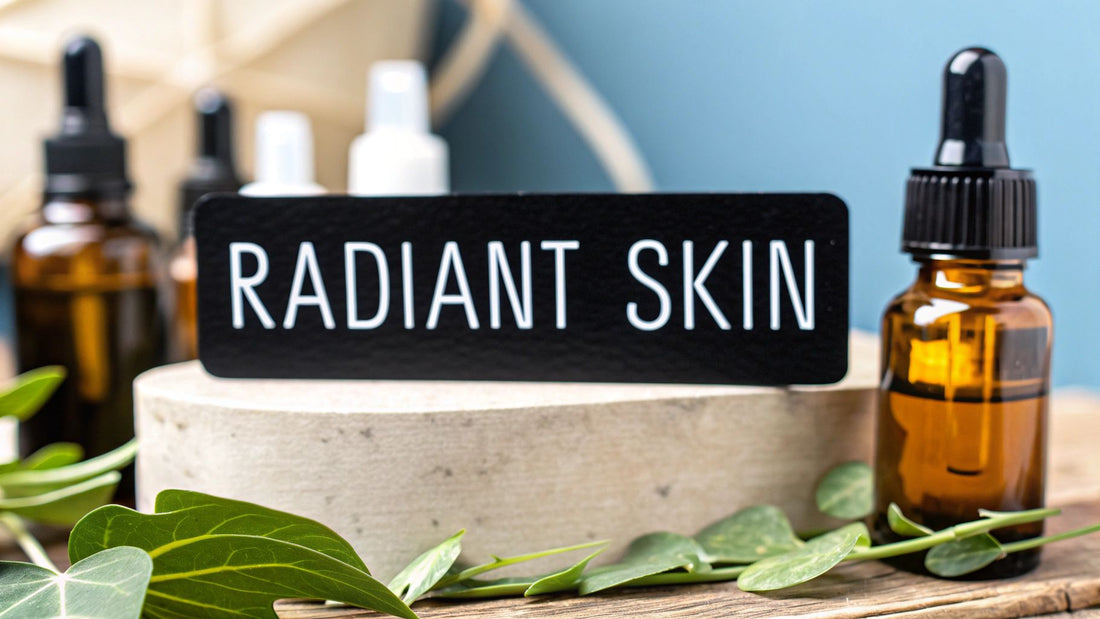
The Undeniable Skin Benefits of Castor Oil: Your Complete Guide
Share
For centuries, castor oil has been the trusted secret for radiant skin. This is no fleeting trend; it’s a powerhouse remedy renowned for its profound ability to moisturize, conquer inflammation, and fend off microbes. With just this one formidable ingredient, you have the power to calm persistent irritation, erase dry patches, and forge a path to a clearer, more luminous complexion.
The Ancient Secret to Modern Glowing Skin
Long before the era of complex serums and elaborate routines, ancient civilizations like the Egyptians and Greeks held a simple, yet potent secret for immaculate skin: castor oil. This isn't merely an old-fashioned remedy; it is a time-proven solution that masterfully addresses the very skin concerns we battle today.
The reason it's surging back into the spotlight isn't hype—it's because it delivers real, tangible results. Pressed from the seeds of the Ricinus communis plant, this unassuming oil offers a direct, natural pathway to visibly healthier skin.
Its undeniable power is rooted in its unique chemical structure. Castor oil is overwhelmingly rich in a rare and powerful fatty acid called ricinoleic acid. This is the oil’s superstar, the principal component doing all the transformative work for your skin. It's what sets castor oil apart from every other plant oil and endows it with such potent, therapeutic properties.
Why Its Composition Is Your Skin's Greatest Ally
That high concentration of ricinoleic acid is precisely what transforms castor oil into a skincare champion. Cultures worldwide have harnessed this power for centuries, using it to deeply hydrate and soothe like nothing else.
What makes it so profoundly effective is that ricinoleic acid constitutes a staggering 90% of the oil's fatty acid content. This unique compound is a monounsaturated fatty acid that is brilliant at not just infusing moisture into the skin, but locking it in for the long haul. It creates a protective shield on the surface, dramatically slowing down water loss and ensuring your skin remains soft and hydrated for hours on end. You can explore the science behind these undeniable benefits with resources like Medical News Today.
The true power of castor oil lies in its elegant simplicity. It doesn’t need a long list of synthetic ingredients to be effective; it relies on one dominant, naturally occurring fatty acid that masterfully soothes, hydrates, and defends your skin.
This is a close-up of the castor oil plant leaves, the source of this beneficial oil.
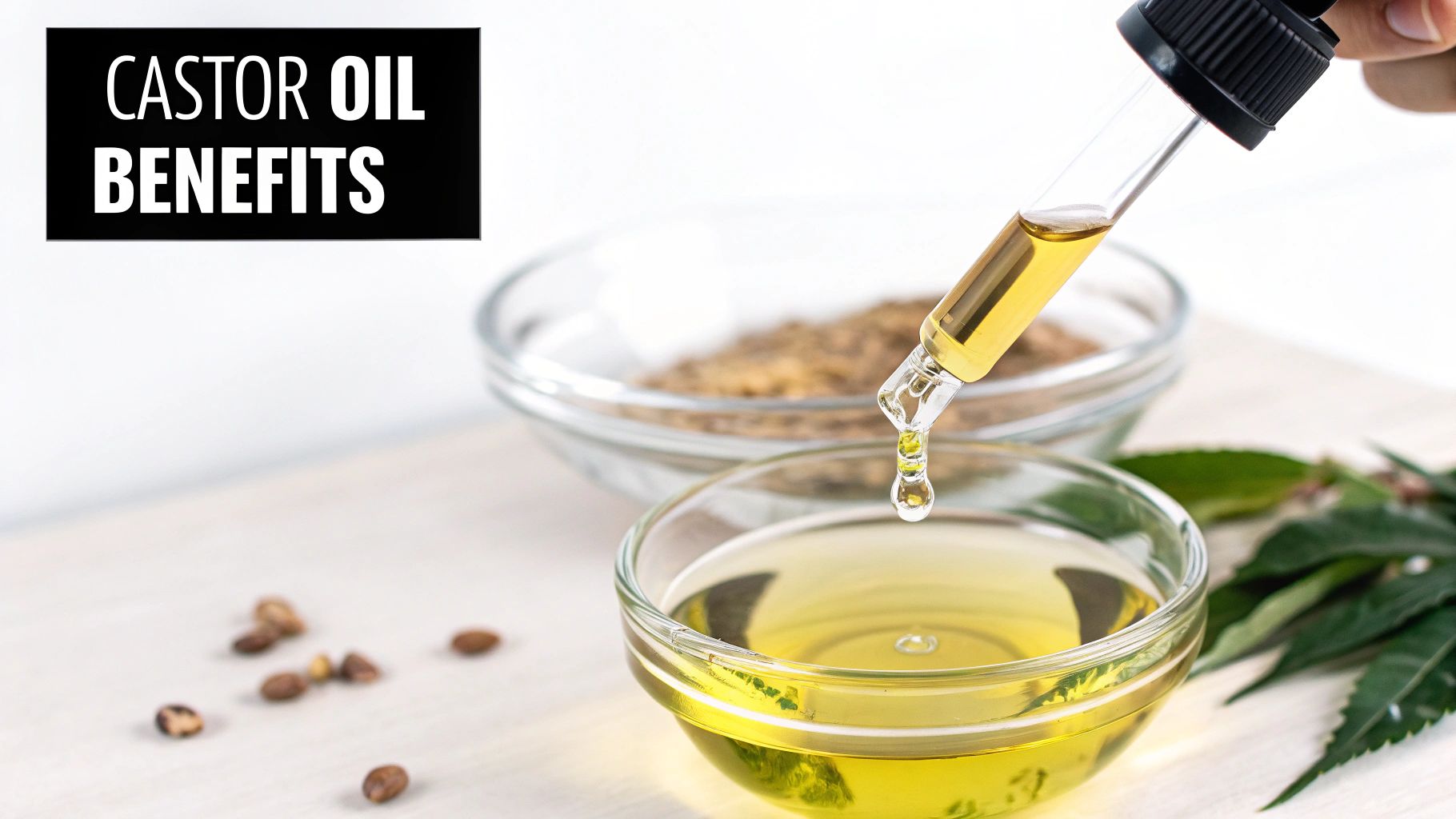
The vibrant, resilient appearance of the plant itself is a testament to the robust, nourishing oil it yields. Understanding its origin connects its ancient legacy to its vital role in modern clean beauty.
To give you a clear overview, here is a breakdown of how castor oil's unique composition translates into real, visible skin benefits.
Castor Oil At-a-Glance Skin Benefits
| Benefit | Primary Active Component | How It Helps Your Skin |
|---|---|---|
| Deep Moisturization | Ricinoleic Acid | Acts as a humectant, drawing moisture in, and an occlusive, locking it down. |
| Anti-Inflammatory | Ricinoleic Acid | Calms redness and soothes irritation associated with conditions like acne or sunburn. |
| Antimicrobial | Undecylenic Acid (a derivative) | Fights bacteria and fungi that can cause skin infections and breakouts. |
| Promotes Healing | Fatty Acids & Vitamin E | Supports tissue growth, helps reduce scarring, and protects against environmental damage. |
This table proves just how much transformative work that one key ingredient—ricinoleic acid—is doing.
This natural origin story is crucial for appreciating why people have trusted the castor oil skin benefits for generations. This is not a fleeting trend but a scientifically validated, nature-derived solution. As we explore further, you will see how this ancient secret is poised to become the cornerstone of your modern skincare routine, delivering clear, undeniable results.
How Castor Oil Actually Transforms Your Skin
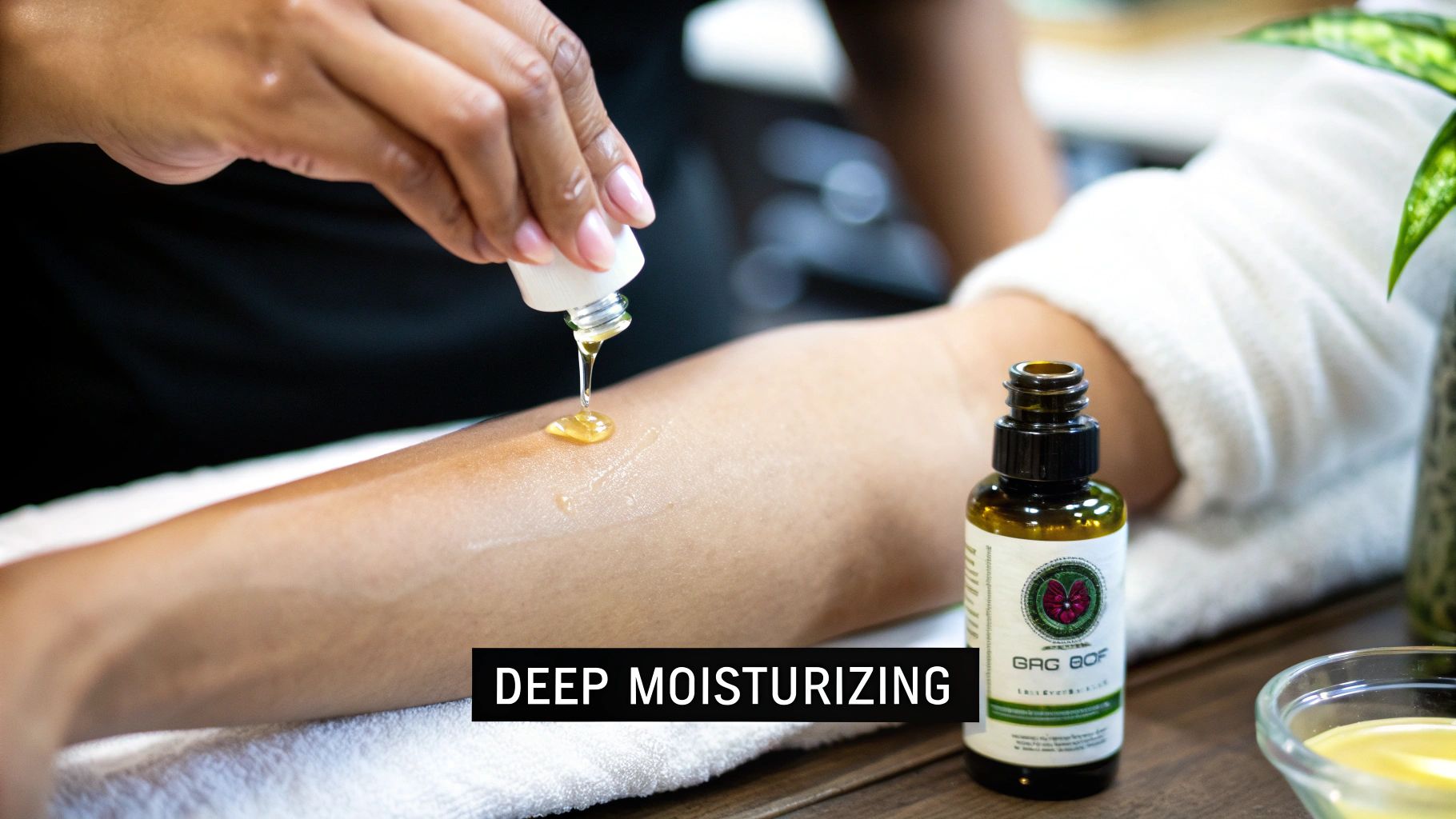
To truly grasp why castor oil is a skincare game-changer, you must look beyond its historic reputation and understand the powerful chemistry at work. This isn't magic; it's science. This unique oil possesses potent properties that work in concert to calm, hydrate, and protect your skin with unmatched efficacy.
The undisputed hero is ricinoleic acid. This unique fatty acid, making up about 90% of the oil, functions as a personal bodyguard for your skin. It is the driving force behind the three pillars of castor oil's effectiveness: extinguishing inflammation, delivering unparalleled moisture, and neutralizing harmful bacteria.
Let's dissect how each of these actions works to give you the best skin of your life.
Your Skin’s Personal Firefighter
Inflammation is the sworn enemy of healthy skin—it's the root of everything from the angry redness of a breakout to chronic puffiness and sensitivity. Ricinoleic acid is the natural firefighter your skin has been waiting for. When your skin becomes irritated, it triggers an inflammatory response, creating visible redness and swelling.
Castor oil swoops in to extinguish the fire. Its formidable anti-inflammatory nature soothes skin on contact, visibly reducing irritation almost immediately. This is precisely why it works so brilliantly to tame an aggressive pimple or instantly take the sting out of a mild sunburn.
By targeting the source of inflammation, castor oil establishes a calm, balanced environment where your skin can truly thrive. This is the essential first step toward building healthier, more resilient skin.
The Ultimate Moisture Magnet
Is your skin perpetually dry or flaky? This is a clear signal that it's failing to retain water. This is where castor oil's second talent comes into play—it’s an extraordinary hydrator.
Imagine your skin is a parched sponge, unable to absorb or hold onto any moisture. Castor oil solves this problem with a brilliant two-pronged attack:
- It’s a humectant: It literally pulls moisture from the air and draws it deep into the top layers of your skin, giving it a vital drink of water it couldn't get on its own.
- It’s an occlusive: Its rich, viscous texture forms an impenetrable protective barrier over your skin. This shield locks all that precious moisture in, preventing it from escaping throughout the day.
This one-two punch delivers far more than a temporary fix. It actively rebuilds your skin’s natural moisture barrier, culminating in a complexion that looks and feels profoundly plump, smooth, and supple. Even those fine lines, exaggerated by dehydration, begin to visibly fade.
Castor oil doesn't just sit on your skin; it actively manages its hydration levels. By both attracting and sealing in moisture, it provides a comprehensive solution for lasting softness and elasticity.
A Guardian Against Unwanted Bacteria
Finally, let's talk about castor oil's role as a gentle but firm gatekeeper. Your skin hosts a variety of bacteria, some of which are the direct culprits behind clogged pores and acne. Castor oil's innate antimicrobial properties effectively keep these troublemakers in check.
This doesn't mean it's harsh or stripping like many acne-fighting chemicals. Instead, it fosters a healthier balance on your skin's surface, creating an environment where acne-causing bacteria simply cannot thrive.
Using it as a spot treatment or as part of an oil cleansing routine will purge pores without devastating your skin's moisture. For anyone who battles breakouts or congested skin, this is a revolutionary advantage. By combining its anti-inflammatory and antimicrobial power, castor oil attacks blemishes from two sides, paving the way for a consistently clear complexion.
Unlocking Your Most Radiant Skin
Now that you understand the science, let's focus on the results you can see in the mirror. Castor oil is so much more than a simple moisturizer. It is a multi-tool for your skin, expertly equipped to resolve the most common and frustrating issues we all face, from persistent dryness and fine lines to stubborn acne and uneven skin tone.
Imagine your skin as a garden. To flourish, it demands water, nutrients, and protection from the elements. Castor oil delivers on all three fronts, working synergistically to restore your skin's balance and reveal a healthy, vibrant glow.
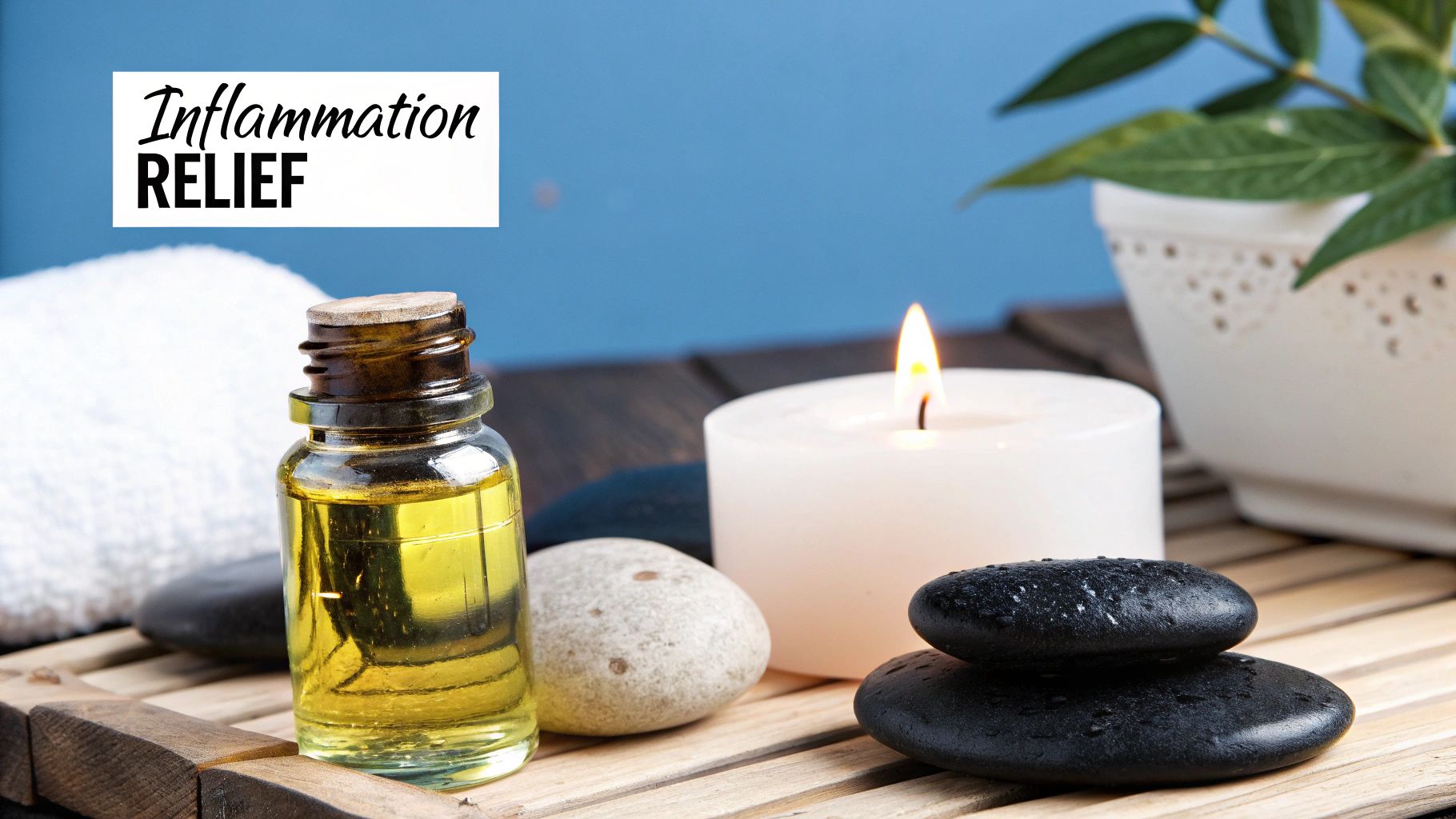
Let's break down the most impressive castor oil skin benefits and see how this one simple ingredient can make a profound difference.
Transforming Dry and Flaky Skin
If you’ve ever endured seriously dry skin, you know that tight, itchy, and flaky feeling all too well. This is the telltale sign that your skin's natural moisture barrier—its frontline defense—is compromised.
Castor oil acts as an elite repair crew. Its rich, emollient texture immediately forms a protective shield, stopping moisture from escaping. Simultaneously, it actively pulls hydration from the air into your skin, completely quenching its thirst.
This dual-action approach transforms dry, parched skin into a soft, supple, and comfortable canvas. It’s like giving your skin a massive drink of water and then locking that moisture in for lasting relief.
Diminishing Fine Lines and Wrinkles
Dehydration is the primary reason fine lines appear more prominent. When your skin loses moisture, it loses its plumpness, causing those creases to look deeper and more pronounced than they really are.
This is where castor oil's intense hydrating power truly excels. By flooding your skin with moisture and sealing it in, the oil plumps everything up from within. This creates an immediate "filling" effect, making fine lines appear significantly softer and less noticeable.
Beyond that, castor oil is packed with antioxidants that empower your skin to fight off free radicals—the environmental aggressors that accelerate the aging process. With consistent use, it fortifies your skin's natural elasticity and firmness, ensuring a smoother appearance over time.
Castor oil's magic isn't about erasing wrinkles overnight. It's about giving your skin the deep, lasting hydration and antioxidant support it needs to stay resilient and plump on its own.
Calming and Preventing Acne Breakouts
I know what you're thinking—oil on acne-prone skin? It sounds counterintuitive, but castor oil is different. Most breakouts are a combination of bacteria, inflammation, and clogged pores. Castor oil wages war on the first two.
Its potent anti-inflammatory properties are phenomenal at soothing the redness and swelling of an active blemish, dramatically accelerating its healing time. Think of it as a calming compress for angry, irritated skin.
Simultaneously, its antimicrobial power keeps acne-causing bacteria at bay. By making your skin an inhospitable environment for these germs, it helps prevent new breakouts before they can even form. This makes it an unparalleled spot treatment or a powerful addition to your cleansing routine. If you're curious about its other applications, you can read our guide on what castor oil is good for to learn more.
Evening Out Skin Tone and Reducing Hyperpigmentation
Dark spots, sun spots, and post-acne marks can leave your complexion looking uneven and blotchy. Castor oil is a proven ally in restoring a balanced, luminous tone. The fatty acids in the oil penetrate deep into the skin, stimulating the growth of healthy new cells.
This regeneration process gently fades areas of hyperpigmentation over time. As fresh, healthy skin cells migrate to the surface, those discolored spots gradually become lighter and less visible.
This isn't just anecdotal; modern science confirms it. A 2023 clinical trial tested a castor oil-based cream on dark under-eye circles, an issue affecting up to 16% of adults. The study revealed significant reductions in melanin, wrinkles, and sagging. This proves that castor oil not only lightens pigmentation but also improves the skin's overall texture and firmness. You can dive into the full study on how castor oil improves skin firmness and hyperpigmentation.
How to Use Castor oil in Your Skincare Routine
Knowing about the incredible benefits of castor oil is one thing; putting it to work to achieve those results is another. Incorporating this thick, nutrient-dense oil into your daily routine is surprisingly simple once you master the technique. The key is to start small and tailor the application to your skin's specific needs.
Before you begin, there are two non-negotiable golden rules.
First, always perform a patch test. I cannot stress this enough. Dab a small amount of castor oil on a discreet area, like your inner arm, and wait 24 hours. This simple check ensures your skin is compatible before you commit fully.
Second, the quality of your oil is paramount. Settle for nothing less than cold-pressed and hexane-free castor oil. This guarantees you're getting the purest, most potent form of the oil, free from any chemical residues from the extraction process.
Finding the Right Application Method for You
Castor oil is a true multitasker, but its rich consistency means a one-size-fits-all approach is ineffective. You will unlock its full potential by matching the application method to your specific goals, whether that’s deep hydration, gentle cleansing, or eliminating a surprise blemish.
A pro tip for making it easier to handle is to blend it with a lighter carrier oil, like jojoba or almond oil. This creates your own custom-blended super-serum. A 50/50 ratio is an excellent starting point, but feel free to adjust until you find the perfect texture for your skin. For a deeper dive into different blends and applications, check out our guide on organic castor oil uses.
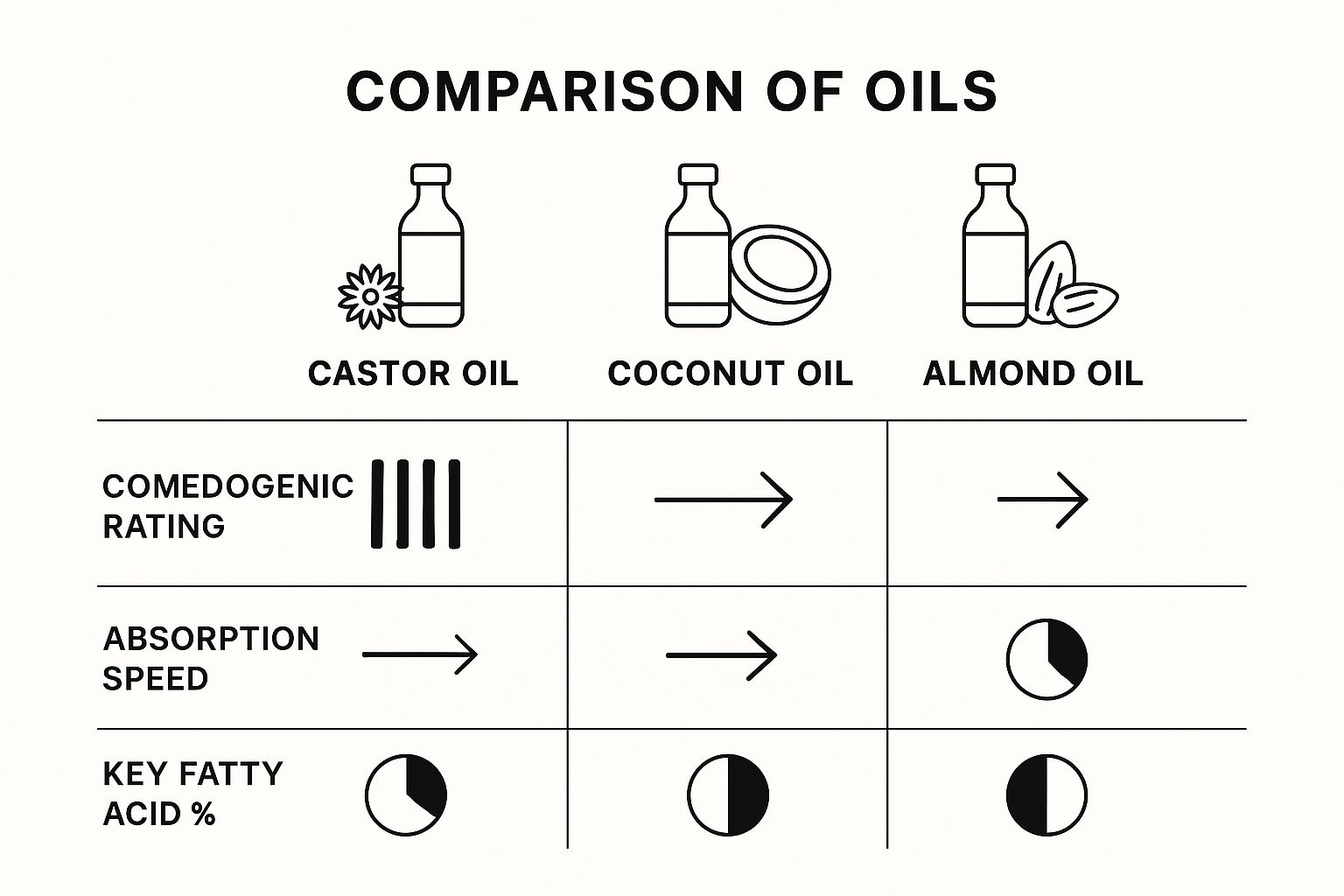
As you can see, castor oil’s impressively low comedogenic rating is a game-changer, especially for anyone worried about clogged pores. It stands out from heavier oils like coconut oil for this very reason.
To make things crystal clear, let's break down exactly how you can use castor oil for different skin concerns.
Castor Oil Application Methods for Different Skin Concerns
| Skin Concern | Application Method | Recommended Carrier Oil | Frequency |
|---|---|---|---|
| Dryness/Dehydration | As an overnight moisturizer or added to your regular lotion. | Jojoba or Argan Oil | 2-3 times per week, or as needed |
| Acne/Blemishes | Targeted spot treatment directly on pimples. | None needed for spot treatment. | Daily on active blemishes |
| Fine Lines/Wrinkles | Gentle massage on target areas (e.g., under-eyes, forehead). | Rosehip or Almond Oil | 3-4 times per week, preferably at night |
| Clogged Pores/Buildup | Used as an oil cleanser to dissolve sebum and impurities. | Grapeseed or Sunflower Oil | 1-2 times per week |
This table provides an excellent roadmap for integrating castor oil into your routine based on your skin's unique needs.
Step-by-Step Guides for Common Uses
Ready to transform your skin? Here are four simple yet powerful ways to add castor oil to your skincare arsenal.
1. As an Overnight Deep Moisturizer
This is the ultimate solution for when your skin feels dry, flaky, or simply exhausted. Think of it as an intensive hydration mask that works its magic while you sleep.
- After cleansing and toning, warm a few drops of castor oil (or your blend) between your palms.
- Gently press the oil onto your face and neck, concentrating on any particularly dry patches.
- Let it absorb overnight. In the morning, rinse with warm water and greet your new soft, plump skin.
2. As a Gentle Oil Cleanser
Oil cleansing is a superior method for melting away makeup, sunscreen, and daily grime without stripping your skin’s essential protective barrier.
- Start with a dry face. Massage a quarter-sized amount of your castor oil blend into your skin for about a minute.
- Soak a soft washcloth in warm water, wring it out, and drape it over your face for a few seconds to let the steam open your pores.
- Gently wipe everything away. If you practice the double-cleanse method, you can follow up with your favorite water-based cleanser.
The science here is simple: "like dissolves like." The castor oil binds to oil-based impurities in your pores and lifts them away, leaving your skin deeply clean but never tight or dry.
3. As a Targeted Spot Treatment
With its natural anti-inflammatory power, castor oil is a brilliant spot treatment for angry blemishes.
- Complete your normal skincare routine.
- Dip a clean cotton swab into a tiny amount of pure castor oil.
- Dab it directly onto any pimples or areas of redness.
- Leave it on overnight to significantly calm redness and swelling by morning.
4. As a Soothing Under-Eye Treatment
The delicate skin around your eyes craves the deep hydration and plumping effect of castor oil.
- Using your ring finger (which applies the least pressure), gently tap a minuscule amount of oil under and around your eyes.
- Be extremely careful not to get it in your eyes.
- This simple nightly ritual will soften the appearance of fine lines by delivering a major moisture surge to this fragile area.
Safety Precautions and Potential Side Effects
Castor oil is a phenomenal natural product, but just because it's from a plant doesn't mean it's right for everyone. As with any powerful skincare ingredient, understanding how to use it safely is crucial to unlocking its benefits without any unwelcome surprises.
Think of it like trying a new, spicy dish—you wouldn't dive in without a small taste first. The same principle applies here. Before you even consider applying castor oil to your face, you absolutely must perform a patch test.
Always Start with a Patch Test
A patch test is non-negotiable. It's a simple, foolproof way to determine how your skin will react before you commit to using it on a larger area. It’s your skin's way of giving you the green light.
Here’s the right way to do it:
- Choose a hidden spot: Dab a small amount of castor oil on a discreet area, like the inside of your wrist or just behind your ear.
- Cover and wait: Place a small bandage over it and leave it undisturbed for a full 24 hours.
- Check the results: After a day, remove the bandage and carefully examine the skin. Look for any signs of redness, itching, swelling, or irritation.
If your skin looks and feels completely normal, you're clear for takeoff. But if you notice any reaction, no matter how minor, it's a clear sign that castor oil is not for you.
Who Should Be Cautious
While countless people achieve incredible results with castor oil, it's not a universal panacea. If you have highly sensitive skin or are prone to conditions like eczema or dermatitis, its rich, thick consistency might be too occlusive and could potentially cause irritation.
The same warning applies to those with very acne-prone skin. While castor oil has a low comedogenic rating, its heavy texture can trap oil and bacteria if not cleansed thoroughly. For some individuals, this could inadvertently lead to more breakouts.
The goal is to work with your skin, not against it. If your skin is signaling that something isn't right, it's vital to listen and adjust your routine.
Debunking Myths and Understanding Side Effects
Let's dismantle a dangerous misconception: castor oil is not a first-aid remedy for open wounds. You should never apply castor oil to broken skin, cuts, or open sores without direct medical guidance. Doing so can trap bacteria and lead to a serious infection.
It is true that castor oil is used in some medical settings. Specialized ointments like 'Venelex' are used in hospitals to help heal skin ulcers by creating a moist, anti-inflammatory barrier. But this is always administered under professional supervision, not as a DIY home remedy. You can find more information on its medical applications on WebMD.com.
Potential side effects are typically mild, but awareness is key:
- Skin irritation or a rash, particularly if you have an undiagnosed allergy.
- Clogged pores, which can occur if the oil isn't fully removed, especially on oily skin types.
- Eye irritation if you accidentally get it in your eyes.
By adhering to these simple safety protocols, you can confidently explore the benefits of castor oil and achieve remarkable results without any of the risks.
Your Questions About Castor Oil Answered
Diving into the world of natural oils can feel intimidating, and castor oil is no exception. With its unique, thick texture and powerful reputation, having questions is natural. Let's demystify the most common uncertainties so you can feel completely confident incorporating it into your routine.
We’ll tackle the three biggest questions: Will it clog your pores? How long until you actually see results? And which type of castor oil is the absolute best for your face?
Will Castor Oil Clog My Pores?
This is the number one concern, and it's a valid one. The idea of putting a thick, heavy oil on your face—especially if your skin is oily or prone to breakouts—seems like a recipe for disaster.
Here’s the definitive answer: castor oil has a very low comedogenic rating, typically a 1 on a scale of 0 to 5. This means it is highly unlikely to clog pores for most people. Think of the comedogenic scale as a traffic report for your pores; a 5 is a complete clog, while a 0 or 1 means traffic is flowing freely.
However, how you use it is critical. Because it's so thick, simply slathering it on and leaving it could potentially trap other oils and bacteria, leading to breakouts.
The secret to using castor oil without clogging pores isn't avoiding it, but using it intelligently. Proper application and removal are what make it a friend, not a foe, to your skin.
To unlock all the amazing castor oil skin benefits without the worry, just follow these simple rules:
- Dilute It: Mix castor oil with a lighter, non-comedogenic oil like jojoba or grapeseed. A 50/50 blend is an excellent starting point. This thins its consistency, making it easier to apply and less heavy on the skin.
- Use It for Oil Cleansing: This is one of the best ways to harness its power. The principle "like dissolves like" means castor oil excels at breaking down and lifting away makeup, excess sebum, and grime from deep within your pores. When you wipe it away with a warm cloth, you remove all that debris with it.
- Apply Sparingly: A little goes a very, very long way. You only need a few drops for your entire face. Warm the oil between your palms first to make it more pliable, then gently press it into your skin instead of rubbing.
By using these methods, you can tap into its moisturizing and anti-inflammatory powers without ever overwhelming your skin.
How Long Until I See Results?
We all crave instant gratification, but with skincare, patience and consistency are your greatest assets. With castor oil, some benefits are immediate, while others require dedication to fully emerge.
You will feel the moisture boost almost instantly. After just one use as an overnight treatment, you will wake up to skin that feels noticeably softer, plumper, and more hydrated. This immediate effect is due to its powerful ability to draw in and lock down moisture.
For the deeper, more transformative benefits—like softening fine lines, evening out skin tone, or calming persistent acne—you must give it time to work its magic.
Think of it like nurturing a plant. The soil gets damp right away, but it takes weeks of consistent care for the plant to grow stronger and flourish. Your skin operates on a similar timeline. Consistent use allows the ricinoleic acid to quell inflammation and the fatty acids to support healthy skin cell turnover.
Here’s a realistic timeline of what you can expect:
- Immediate (1-2 Uses): Softer skin texture, diminished flakiness, and a visible boost in hydration.
- Short-Term (2-4 Weeks): A significant reduction in redness and inflammation. Acne will appear less angry and heal faster.
- Long-Term (1-3 Months): You can expect to see a real improvement in the appearance of fine lines, a more even skin tone, and a visible softening of dark spots or acne scars.
Consistency is everything. Using it a few times a week, every single week, is what will deliver those incredible, long-lasting results.
Which Type of Castor Oil Is Best for Skin?
Walk into any health store and the different bottles of castor oil can be confusing. You’ll mainly encounter three types: cold-pressed, Jamaican black, and hydrogenated. For your face, there is one undisputed champion.
Cold-Pressed Castor Oil
This is the gold standard for skincare, period. It's extracted from castor seeds using a mechanical press without heat. This gentle process preserves all the vital nutrients—vitamins, minerals, and that all-important ricinoleic acid. It's typically a pale yellow color with a very mild scent. For your face, always insist on 100% pure, cold-pressed, and hexane-free castor oil.
Jamaican Black Castor Oil (JBCO)
JBCO is produced by first roasting the castor beans, which gives the oil its characteristic dark color and a strong, smoky aroma. The ash from roasting is mixed in, raising the oil's pH. While it's fantastic for promoting hair growth and clarifying the scalp, this alkaline version can be too harsh and drying for the delicate skin on your face.
Hydrogenated Castor Oil (Castor Wax)
This isn’t something you’d use directly on your skin. It's castor oil that has been chemically processed into a hard, waxy solid. You’ll find it in cosmetics like lipsticks and deodorants as a thickener, but it lacks the raw, therapeutic nutrients you need for skincare.
Here's a quick cheat sheet to make it simple:
| Type of Castor Oil | Extraction Method | Appearance | Best For |
|---|---|---|---|
| Cold-Pressed | Mechanical pressing, no heat | Pale yellow, mild odor | Facial skincare, moisturizing, anti-inflammatory benefits |
| Jamaican Black | Roasting, then pressing | Dark brown, strong odor | Hair and scalp treatments, clarifying |
| Hydrogenated | Chemical hydrogenation | White, waxy solid | Cosmetic formulations as an emulsifier or thickener |
To truly reap the best castor oil skin benefits, cold-pressed is the only choice. It is the purest, most nutrient-dense version available, delivering everything your skin needs without compromise.
Ready to experience the hydrating and soothing power of the purest castor oil? At terravera, our Niya Organica Castor Oil is 100% pure, cold-pressed, and hexane-free, ensuring you get all the benefits without compromise. Transform your skincare routine today.
